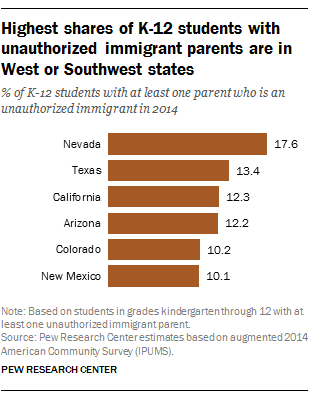See the most recent estimates of the U.S. unauthorized immigrant population, published June 12, 2019.
About 3.9 million kindergarten through 12th-grade students in U.S. public and private schools in 2014 – or 7.3% of the total – were children of unauthorized immigrants, according to new Pew Research Center estimates based on government data. These estimates reflect an increase since the end of the Great Recession in 2009, when such students numbered 3.6 million and accounted for 6.6% of the total.

The rise in K-12 students with at least one parent who is an unauthorized immigrant contrasts with the total number of unauthorized immigrants, which has remained stable since 2009.
Before 2009, the trends had been similar, with both groups rising in number from 1995 to 2007 (the year the recession began), then declining to a lower level in 2008. The number of students with at least one unauthorized immigrant parent ticked up in 2009. (To learn more, see our interactive map.)
The vast majority of students with at least one unauthorized immigrant parent – 3.2 million, or 5.9% of total enrollment in 2014 – were U.S.-born children and thus U.S. citizens at birth. The rest (about 725,000 students, or 1.3% of total enrollment in 2014) were unauthorized immigrants themselves. In other words, U.S.-born children made up 81% of all children of unauthorized immigrants enrolled in grades K-12 in 2014. (Well under 1% of children of unauthorized immigrants were lawful immigrants in 2014.)
Since the end of the Great Recession, the growth in the number of students with unauthorized immigrant parents has been entirely due to a broader increase in the number of children born in the U.S. The number of students who are unauthorized immigrants themselves (and their share of the total) has declined.

Long-term residents constitute a rising share of the nation’s unauthorized immigrant population, making it more likely for them to have U.S.-born children. In 2014, two-thirds of adult unauthorized immigrants had lived in the U.S. for a decade or more, compared with 41% in 2005.
Pew Research Center estimates that in 2014, 4 million unauthorized immigrant adults, or 39% of the total, lived with their minor or adult U.S.-born children, compared with 2.1 million, or 30%, in 2000. (The total number of unauthorized immigrants with minor or adult children born in the U.S. may well be higher, as these figures do not count those who live separately from their children.)
Separately, the number of births to unauthorized immigrants has declined since 2009, according to other Pew Research Center estimates. There were about 275,000 births to unauthorized immigrants in 2014, compared with about 330,000 in 2009. However, this recent decline is not fully reflected in the Center’s school enrollment estimates because most of these children are not yet of school age.
States in the West and Southwest tend to have the highest shares of K-12 students with unauthorized immigrant parents. In six states, the share is 10% or more: Nevada (17.6%) ranked first, followed by Texas (13.4%), California (12.3%), Arizona (12.2%), Colorado (10.2%) and New Mexico (10.1%). California and Texas had about the same share of students with unauthorized immigrant parents in 2012, but by 2014, California’s share had dropped below that of Texas. At the other end of the spectrum, the share of students with unauthorized immigrant parents was less than 1% in six states, mainly in the Midwest and Northeast.
Estimates for the nation and each state on the share of students with at least one unauthorized immigrant parent can be found in an interactive graphic, which also includes state and national estimates on unauthorized immigrants overall, unauthorized immigrants in the workforce and the share of unauthorized immigrants who are of Mexican origin.

